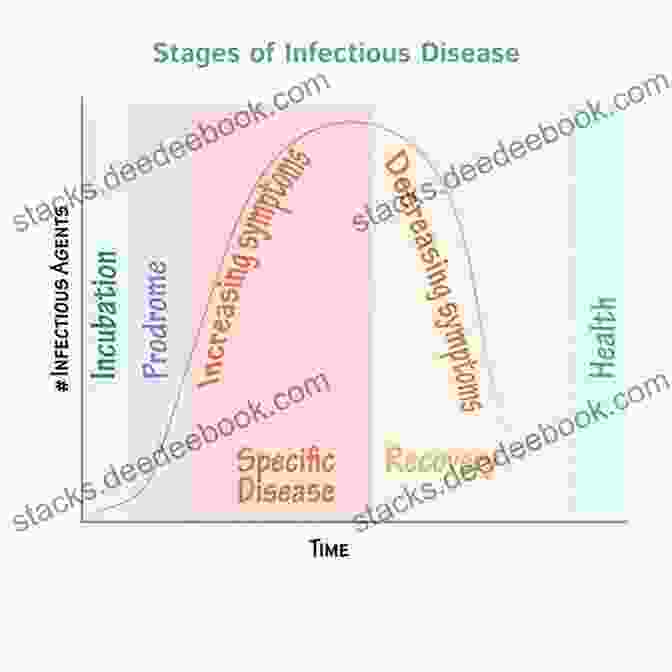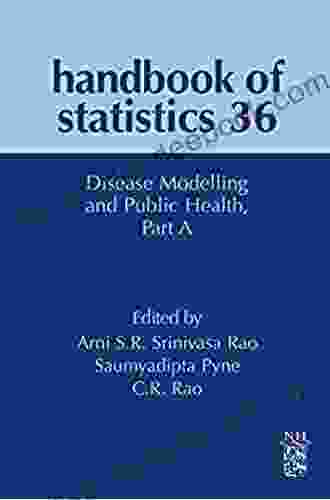Disease Modelling and Public Health: A Comprehensive Analysis

4.1 out of 5
| Language | : | English |
| File size | : | 42916 KB |
| Text-to-Speech | : | Enabled |
| Screen Reader | : | Supported |
| Enhanced typesetting | : | Enabled |
| Print length | : | 468 pages |
Disease modelling is a powerful tool that plays a crucial role in public health. It allows researchers to predict the spread of diseases, evaluate the effectiveness of interventions, and develop strategies to control outbreaks. In this article, we will provide a comprehensive overview of disease modelling techniques, their applications in public health, and the challenges and opportunities in this field.
Types of Disease Models
There are numerous types of disease models, each with its own strengths and weaknesses. Some of the most common types include:
- Deterministic models: These models assume that the state of the population (e.g., the number of infected individuals) changes smoothly over time. They are often used for long-term predictions and to evaluate the impact of different interventions.
- Stochastic models: These models take into account random events that can affect the spread of disease. They are often used for short-term predictions and to assess the risk of outbreaks.
- Individual-based models: These models simulate the behavior of individual agents (e.g., people) within a population. They are often used to study the spread of diseases in complex social networks.
- Agent-based models: These models combine elements of both individual-based and stochastic models. They are often used to study the spread of diseases in populations where the behavior of individuals is influenced by their interactions with others.
Applications of Disease Modelling in Public Health
Disease modelling has a wide range of applications in public health. Some of the most important include:
- Predicting the spread of diseases: Disease models can be used to predict the number of cases that will occur over time, the geographic areas that will be most affected, and the duration of the outbreak.
- Evaluating the effectiveness of interventions: Disease models can be used to evaluate the effectiveness of different interventions, such as vaccination, social distancing, and contact tracing.
- Developing strategies to control outbreaks: Disease models can be used to develop strategies to control outbreaks, such as identifying and isolating infected individuals, implementing travel restrictions, and closing schools and businesses.
- Pandemic preparedness: Disease models can be used to develop plans for pandemic preparedness, such as identifying critical resources, training healthcare workers, and developing contingency plans.
- Health policy: Disease models can be used to inform health policy decisions, such as setting vaccination schedules, allocating resources, and developing public health regulations.
Challenges and Opportunities in Disease Modelling
While disease modelling is a powerful tool, it is not without its challenges. Some of the most significant challenges include:
- Data limitations: Disease models rely on accurate data to make predictions. However, data on disease incidence, prevalence, and transmission rates is often incomplete, inaccurate, or unavailable.
- Model complexity: Disease models can be complex and computationally demanding. This can make it difficult to develop and use models that are both accurate and practical.
- Uncertainty: Disease models are inherently uncertain, as they are based on assumptions about the spread of disease. This uncertainty can make it difficult to interpret the results of disease models and to make decisions based on them.
Despite these challenges, there are also significant opportunities for the use of disease modelling in public health. Some of the most promising areas for future research include:
- Improving data collection: By improving data collection efforts, we can improve the accuracy and reliability of disease models.
- Developing more sophisticated models: By developing more sophisticated models, we can capture the complexity of disease spread and make more accurate predictions.
- Reducing uncertainty: By incorporating uncertainty into disease models, we can make better decisions about how to use them.
- Expanding the use of disease models: By expanding the use of disease models to new areas, such as chronic diseases and mental health, we can improve the health of populations worldwide.
Disease modelling is a powerful tool that plays a vital role in public health. By predicting the spread of diseases, evaluating interventions, and developing control strategies, disease models help us to protect the health of our communities and save lives. As we continue to improve our understanding of disease spread and develop more sophisticated models, we will be able to use this powerful tool to improve the health of populations worldwide.

| Disease | Model Type | Application |
|---|---|---|
| Influenza | Deterministic | Predicting the number of cases during an influenza season |
| Measles | Stochastic | Evaluating the effectiveness of vaccination campaigns |
| HIV/AIDS | Individual-based |
4.1 out of 5
| Language | : | English |
| File size | : | 42916 KB |
| Text-to-Speech | : | Enabled |
| Screen Reader | : | Supported |
| Enhanced typesetting | : | Enabled |
| Print length | : | 468 pages |
Do you want to contribute by writing guest posts on this blog?
Please contact us and send us a resume of previous articles that you have written.
 Novel
Novel Page
Page Chapter
Chapter Story
Story Reader
Reader Newspaper
Newspaper Shelf
Shelf Bibliography
Bibliography Foreword
Foreword Preface
Preface Synopsis
Synopsis Footnote
Footnote Codex
Codex Bestseller
Bestseller Classics
Classics Library card
Library card Biography
Biography Memoir
Memoir Encyclopedia
Encyclopedia Dictionary
Dictionary Thesaurus
Thesaurus Narrator
Narrator Librarian
Librarian Card Catalog
Card Catalog Borrowing
Borrowing Periodicals
Periodicals Scholarly
Scholarly Lending
Lending Academic
Academic Journals
Journals Reading Room
Reading Room Rare Books
Rare Books Special Collections
Special Collections Interlibrary
Interlibrary Literacy
Literacy Study Group
Study Group Dissertation
Dissertation Awards
Awards Book Club
Book Club Textbooks
Textbooks Shelagh Hubbard
Shelagh Hubbard Katherine Kirkpatrick
Katherine Kirkpatrick Steven Casey
Steven Casey Caimh Mcdonnell
Caimh Mcdonnell Donna Douglas
Donna Douglas Bernard E Harcourt
Bernard E Harcourt Will Cordeiro
Will Cordeiro Clara Meath
Clara Meath Christopher Hauke
Christopher Hauke Jeff Gross
Jeff Gross Gayle Trotter
Gayle Trotter Daniel Aston
Daniel Aston Anna Quindlen
Anna Quindlen Allen W Trelease
Allen W Trelease Adriana Locke
Adriana Locke Rene Schreiber
Rene Schreiber Anthony Smith
Anthony Smith Wayne Ng
Wayne Ng Paul Polak
Paul Polak Ryunosuke Koike
Ryunosuke Koike
Light bulbAdvertise smarter! Our strategic ad space ensures maximum exposure. Reserve your spot today!

 Ernest ClineThe Politically Incorrect Guide to the British Empire: The Notorious History...
Ernest ClineThe Politically Incorrect Guide to the British Empire: The Notorious History... Ashton ReedFollow ·11.3k
Ashton ReedFollow ·11.3k Greg FosterFollow ·17.6k
Greg FosterFollow ·17.6k Ed CooperFollow ·15.8k
Ed CooperFollow ·15.8k Stephen FosterFollow ·16.5k
Stephen FosterFollow ·16.5k Calvin FisherFollow ·15.6k
Calvin FisherFollow ·15.6k Eli BlairFollow ·2.1k
Eli BlairFollow ·2.1k Edgar CoxFollow ·15.2k
Edgar CoxFollow ·15.2k Corey HayesFollow ·11.9k
Corey HayesFollow ·11.9k

 Amir Simmons
Amir SimmonsMore Zeal Than Discretion: A Closer Look at the Risks and...
Enthusiasm is often seen as a positive...

 Wayne Carter
Wayne CarterYear of the Dog: American Poets Continuum 178
Year of the Dog is a...

 David Foster Wallace
David Foster WallaceThe Constitution of the State of New York: A...
The Constitution of the...

 Harvey Bell
Harvey BellSmall Cetaceans of Japan: Exploitation and Biology
Small cetaceans, including...

 Blake Bell
Blake BellEffortless Elegance: A Comprehensive Guide to Captivating...
In the realm of crocheting,...
4.1 out of 5
| Language | : | English |
| File size | : | 42916 KB |
| Text-to-Speech | : | Enabled |
| Screen Reader | : | Supported |
| Enhanced typesetting | : | Enabled |
| Print length | : | 468 pages |












